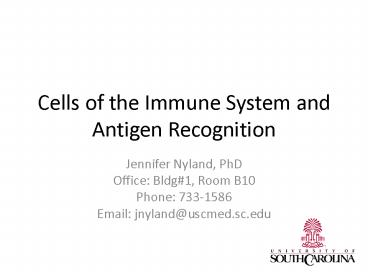Cells of the Immune System and Antigen Recognition PowerPoint PPT Presentation
1 / 28
Title: Cells of the Immune System and Antigen Recognition
1
Cells of the Immune System and Antigen Recognition
- Jennifer Nyland, PhD
- Office Bldg1, Room B10
- Phone 733-1586
- Email jnyland_at_uscmed.sc.edu
2
Teaching objectives
- To review the role of immune cells in protection
from different types of pathogens - To discuss the types of cells involved in immune
responses - To describe the nature of specificity in adaptive
immune responses - To understand the role of lymphocyte
recirculation in immune responses
3
Overview of the immune system
- Purpose
- Protection from pathogens
- Intracellular (viruses, some bacteria and
parasites) - Extracellular (most bacteria, fungi, and
parasites) - Eliminate modified or altered self
- Cancer or transformed cells
- Sites of action
- Extracellular
- Intracellular
4
Overview- extracellular pathogens
- Ab are primary defense
- Neutralization
- Opsonization
- Complement activation
5
Overview- intracellular pathogens
- Cell-mediated responses are primary defense
- Ab are ineffective
- Two scenarios
- Pathogen in cytosol
- Cytotoxic T cell (CD8)
- Pathogen in vesicles
- Th1 (CD4) releases cytokines
- Activates macrophages
6
Cells of the immune system
7
Development of the immune system
8
Phagocytosis and Intracellular killing
- Neutrophils and Macrophages
9
Phagocytes neutrophils (PMNs)
- Characteristic nucleus, cytoplasm
- Granules
- CD66 membrane marker protein
Neutrophil
Geimsa stain Source www.dpd.cdc.gov
10
Characteristics of neutrophil granules
11
Phagocytes macrophages
- Characteristic nucleus
- lysosomes
- CD14 membrane marker protein
Macrophage
Source Dr. Peter Darben, QueenslandUniversity
of Technology, used with permission
12
Non-specific killer cells
- NK cells
- Eosinophils
13
Natural killer (NK) cells
- Also known as large granular lymphocytes (LGL)
- Kill virus-infected or transformed cells
- Identified by the CD56/CD16/CD3-
- Activated by IL-2 and IFN-? to become LAK cells
14
Eosinophils
- Characteristic bi-lobed nucleus
- Cytoplasmic granules, stain with acidic dyes
(eosin) - Major basic protein (MBP)
- Potent toxin for helminths
- Kill parasitic worms
Source Bristol Biomedical Image Archive, used
with permission
15
Mast cells
- Characteristic cytoplasmic granules
- Responsible for burst release of preformed
cytokines, chemokines, histamine - Role in immunity against parasites
Source
16
Cells of the immune system innate
- Phagocytes
- Monocytes/macrophages
- PMNs/neutrophils
- NK cells
- Basophils and mast cells
- Eosinophils
- Platelets
17
Cells of the immune system APC
- Cells that link the innate and adaptive arms
- Antigen presenting cells (APCs)
- Heterogenous population with role in innate
immunity and activation of Th cells - Rich in MHC class II molecules (lec 11-12)
- Examples
- Dendritic cells
- Macrophages
- B cells
- Others (Mast cells)
18
Cells of adaptive immune response
- T cells and B cells
19
Cells of the immune system adaptive
- Lymphocytes
- B cells
- Plasma cells (Ab producing)
- T cells
- Cytotoxic (CTL)
- Helper (Th)
- Th1
- Th2
- Th17
- T-reg
20
Major distinguishing markers
21
Specificity of adaptive immune response
- Resides with Ag R on T and B cells
- TCR and BCR both specific for only ONE
antigenic determinant - TCR is monovalent
- BCR is divalent
22
Specificity of adaptive immune response
- Each B and T cell has receptor that is unique for
a particular antigenic determinant on Ag - Vast array of different AgR in both T and B cell
populations - How are the receptors generated?
- Instructionist hypothesis
- Does not account for self vs non-self
- Clonal selection hypothesis
- AgR pre-formed on B and T cells and Ag selects
the clones with the correct receptor
23
Four principles of clonal selection H?
- Each lymphocyte has a SINGLE type of AgR
- Interaction between foreign molecule and AgR with
high affinity leads to activation - Differentiated effector cell derived from
activated lymphocyte with have the same AgR as
parental lymphocyte (clones) - Lymphocytes bearing AgR for self molecules are
deleted early in lymphoid development and are
absent from repertoire
24
Specificity of adaptive immune response
- Clonal selection H? can explain many features of
immune response - Specificity
- Signal required for activation
- Lag in adaptive immune response
- Discrimination between self and non-self
25
Development of the immune system
26
Lymphocyte recirculation
- Relatively few lymphocytes with a specific AgR
- 1/10,000 to 1/100,000
- Chances for successful encounter enhanced by
circulating lymphocytes - 1-2 recirculate every hour
27
Lymphocyte recirculation
- Lymphocytes enter 2 lymphoid organs via high
endothelial venules (HEVs) - Ag is transported to lymph nodes via APC
- Upon activation, lymphocytes travel to tissues
28
Lymphocyte recirculation
- After activation, new receptors (homing R) are
expressed to direct to tissues - R on lymphocytes recognize CAMs on endothelial
cells - Chemokines at infection help attract activated
lymphocytes

